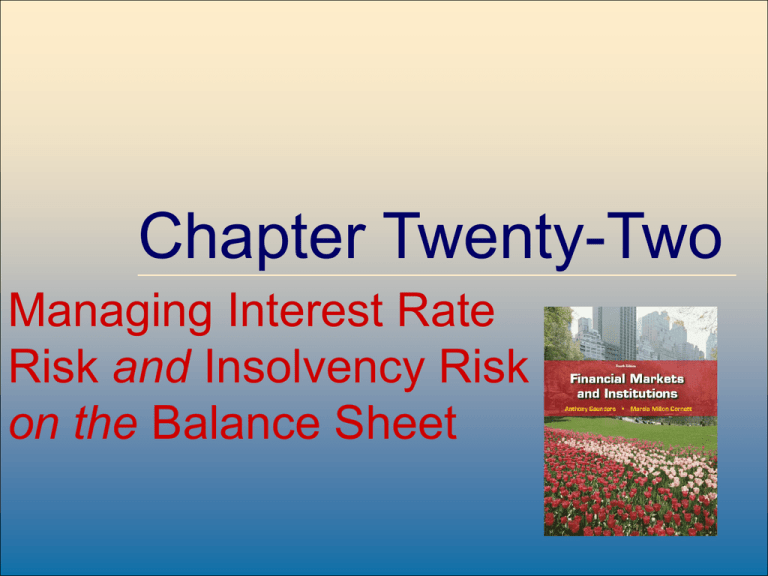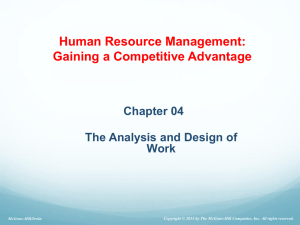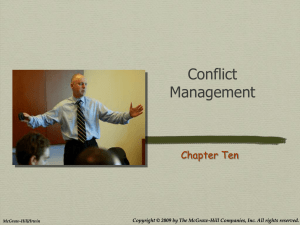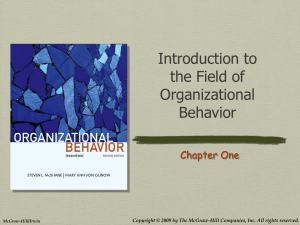
Chapter Twenty-Two
Managing Interest Rate
Risk and Insolvency Risk
on the Balance Sheet
McGraw-Hill/Irwin
8-1
©2009, The McGraw-Hill Companies, All Rights Reserved
Interest Rate Risk
• The asset transformation function performed by
financial institutions (FIs) often exposes them to
interest rate risk
• FIs use (at least) two methods to measure interest rate
exposure
– the repricing model (a.k.a. the funding gap model)
examines the impact of interest rate changes on net interest
income (NII)
– the duration model examines the impact of interest rate
changes on the overall market value of an FI and thus
ultimately on net worth
McGraw-Hill/Irwin
22-2
©2009, The McGraw-Hill Companies, All Rights Reserved
Interest Rate Risk
• The U.S. central bank’s (the Federal Reserve’s)
monetary policy is the most direct influence on
the level and movement of interest rates
• Changes in the Federal Reserve’s fed funds target
rate affect all interest rates throughout the
economy
– expansionary monetary policy involves decreases in
the target fed funds rate
– contractionary monetary policy involves increases in
the target fed funds rate
McGraw-Hill/Irwin
22-3
©2009, The McGraw-Hill Companies, All Rights Reserved
The Repricing Model
• The repricing or funding gap is the difference between those
assets whose interest rates will be repriced or changed over
some future period and liabilities whose interest rates will be
repriced or changed over some future period
• Quarterly reporting of commercial bank assets and liabilities is
detailed by maturity bucket (or bin)
–
–
–
–
–
–
one day
more than one day to 3 months
more than 3 months to 6 months
more than 6 months to 12 months
more than 1 year to 5 years
more than 5 years
McGraw-Hill/Irwin
22-4
©2009, The McGraw-Hill Companies, All Rights Reserved
The Repricing Model
• The gap in each bucket or bin is measured as the
difference between the rate-sensitive assets
(RSAs) and the rate-sensitive liabilities (RSLs)
– rate-sensitivity measures the time to repricing of an
asset or liability
• The cumulative gap (CGAP) is the sum of the
individual maturity bucket gaps
• The cumulative gap effect is the relation
between changes in interest rates and changes in
net interest income
McGraw-Hill/Irwin
22-5
©2009, The McGraw-Hill Companies, All Rights Reserved
The Repricing Model
• The change in net interest income for any given
bucket i (ΔNIIi) is measured as:
ΔNIIi – (GAPi)ΔRi = (RSAi – RSLi)ΔRi
where
McGraw-Hill/Irwin
GAPi = the dollar size of the gap between the book
value of rate-sensitive assets and rate-sensitive
liabilities in maturity bucket i
ΔRi = the change in the level of interest rates
impacting assets and liabilities in the ith
maturity bucket
22-6
©2009, The McGraw-Hill Companies, All Rights Reserved
The Repricing Model
• A common cumulative gap of interest to
commercial bank managers is the one-year
repricing gap estimate:
1 year
1 year
NII RSAi RSLi Ri
i 1 day
i 1day
where ΔNII is the cumulative change in net interest
income from all rate-sensitive assets and liabilities
that are repriced within a year given a change in
interest rates ΔRi
McGraw-Hill/Irwin
22-7
©2009, The McGraw-Hill Companies, All Rights Reserved
The Repricing Model
• The spread effect is the effect that a change in
the spread between rates on RSAs and RSLs has
on net interest income as interest rates change
ΔNIIi = (RSAi x ΔRRSA) – (RSLi x ΔRRSL)
• The repricing model has four major weaknesses
– it ignores market value effects of interest rate changes
– it ignores cash flow patterns within a maturity bucket
– it fails to deal with the problem of rate-insensitive asset
and liability runoffs and prepayments
– it ignores cash flows from off-balance-sheet activities
McGraw-Hill/Irwin
22-8
©2009, The McGraw-Hill Companies, All Rights Reserved
The Duration Model
• Duration measures the interest rate sensitivity of an asset
or liability’s value to small changes in interest rates
D
% in the market val ue of a security
R /(1 R)
• The duration gap is a measure of overall interest rate risk
exposure for an FI
• To find the duration of the total portfolio of assets (DA)
(or liabilities (DL)) for an FI
– first determine the duration of each asset (or liability) in the
portfolio
– then calculate the market value weighted average of the duration
of the assets (or liabilities) in the portfolio
McGraw-Hill/Irwin
22-9
©2009, The McGraw-Hill Companies, All Rights Reserved
The Duration Model
• The change in the market value of the asset
portfolio for a change in interest rates is:
R
A A ( DA )
(1 R )
• Similarly, the change in the market value of the
liability portfolio for a change in interest rates is:
R
L L ( DL )
(1 R )
McGraw-Hill/Irwin
22-10
©2009, The McGraw-Hill Companies, All Rights Reserved
The Duration Model
• Finally, the change in the market value of equity
of a FI given a change in interest rates is
determined from the basic balance sheet equation:
A L E A L E
• By substituting and rearranging, the change in net
worth is given as:
R
E ( DA kDL ) A
(1 R)
– where k is L/A = a measure of the FI’s leverage
McGraw-Hill/Irwin
22-11
©2009, The McGraw-Hill Companies, All Rights Reserved
The Duration Model
• The effect of interest rate changes on the market
value of equity or net worth of an FI breaks down
to three effects
– the leverage adjusted duration gap = (DA – kDL)
• measured in years
• reflects the duration mismatch on an FI’s balance sheet
• the larger the gap the more exposed the FI to interest rate risk
– the size of the FI
– the size of the interest rate shock
McGraw-Hill/Irwin
22-12
©2009, The McGraw-Hill Companies, All Rights Reserved
The Duration Model
McGraw-Hill/Irwin
22-13
©2009, The McGraw-Hill Companies, All Rights Reserved
The Duration Model
• Difficulties emerge when applying the duration model to
real-world FI balance sheets
– duration matching can be costly as restructuring the balance sheet
is time consuming, costly, and generally not desirable
– immunization is a dynamic problem
• duration of assets and liabilities change as they approach maturity
• the rate at which the duration of assets and liabilities change may not
be the same
– duration is not accurate for large interest rate changes unless
convexity is modeled into the measure
• convexity is the degree of curvature of the price-yield curve around
some interest rate level
McGraw-Hill/Irwin
22-14
©2009, The McGraw-Hill Companies, All Rights Reserved
Insolvency Risk
• To ensure survival, an FI manager must protect against the
risk of insolvency
• The primary protection against the risk of insolvency is
equity capital
– capital is a source of funds
– capital is a necessary requirement for growth under existing
minimum capital-to-asset ratios set by regulators
• Managers prefer low levels of capital in order to generate
higher return on equity (ROE)
– the moral hazard problem exacerbates this tendency
– the result is an increased likelihood of insolvency
McGraw-Hill/Irwin
22-15
©2009, The McGraw-Hill Companies, All Rights Reserved
Insolvency Risk
• The economic meaning of capital is net worth
– net worth is equal to the difference between the
market value (MV) of an FI’s assets and the market
value of its liabilities
– the market value or mark-to-market value basis
uses balance sheet values that reflect current rather
than historical prices
• Regulatory and accounting-defined capital is
based in whole or in part on historical or book
values (BV)
McGraw-Hill/Irwin
22-16
©2009, The McGraw-Hill Companies, All Rights Reserved
Insolvency Risk
• The market value of capital and credit risk
– declines in current and expected future cash flows on loans lowers
the MV of an FI’s assets
– declines in the MVs of assets is directly charged against the equity
owners’ capital or net worth
– liability holders are only hurt when asset losses exceed equity
capital levels
– thus, equity capital acts as “insurance” protecting liability holders
(and guarantors such as the FDIC) against insolvency risk
• The market value of capital and interest rate risk
– rising interest rates decrease the value of an FI’s assets more than
the value of the FI’s liabilities when the duration gap of the FIs
balance sheet is positive
– again, losses are first charged against equity capital
McGraw-Hill/Irwin
22-17
©2009, The McGraw-Hill Companies, All Rights Reserved
Insolvency Risk
• The book value of equity capital is the difference
between the BV of assets and the BV of liabilities
– the BV of equity is usually composed of the par value of
equity shares, the surplus value of equity shares, and
retained earnings
– the BV of equity does not equal the market value of equity
– managers can manipulate the BV of equity by
• using discretion when timing the recognition of loan losses
• selectively selling assets to inflate reported earnings (and thus
capital)
McGraw-Hill/Irwin
22-18
©2009, The McGraw-Hill Companies, All Rights Reserved
Insolvency Risk
• Interest rate changes have no impact on book values of
assets and liabilities
– FIs can be solvent from a BV perspective, but massively insolvent
from an economic perspective
• The degree to which the BV of equity deviates from the
MV of equity depends on
– interest rate volatility
– examination and enforcement
– loan trading
• The discrepancy between the MV and BV of equity is
measured by the market-to-book ratio
McGraw-Hill/Irwin
22-19
©2009, The McGraw-Hill Companies, All Rights Reserved
Insolvency Risk
• Arguments against using market value accounting
include
– it is difficult to implement
• especially so for small FIs that are not publicly traded
– it introduces an unnecessary degree of variability into
reported earnings
– FIs may be less willing to accept longer-term asset
exposures if they must be continually marked-tomarket
• likely would interfere with FIs’ role as lenders and monitors
and could lead to a “credit crunch”
McGraw-Hill/Irwin
22-20
©2009, The McGraw-Hill Companies, All Rights Reserved









